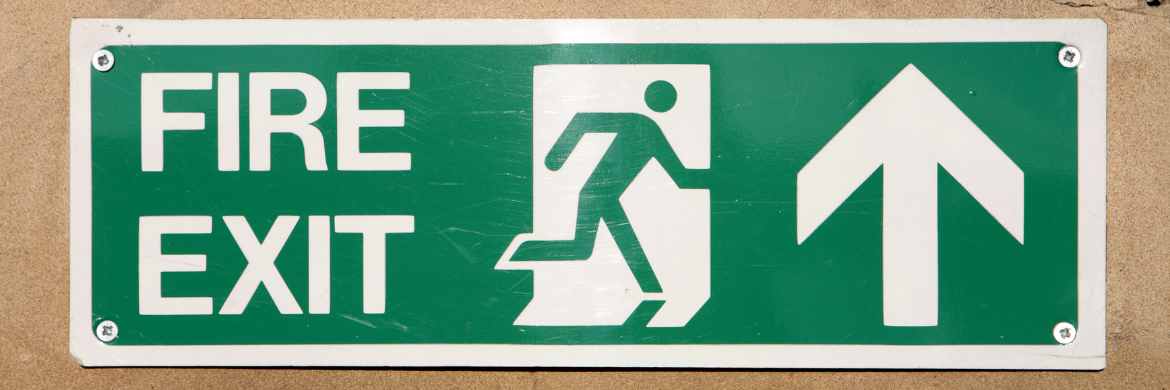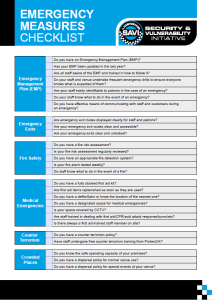Venue Safety: Emergency Measures

As a licensed premises, the security of your venue and the safety of your staff and patrons are of the utmost importance, particularly in case of an emergency. Prevention, and knowing what to do in terms of emergency response measures are necessary to reduce incidents from occurring, and to give staff the ability to effectively deal with issues if they arise.
We discuss some of the main elements of emergency planning in licensed premises – have you checked yours lately?
Emergency Management Plan (EMP)
An Emergency Management Plan (EMP) is an essential tool for any venue, regardless of its size or purpose. It outlines a course of action to mitigate the risk caused by potential events that could endanger a premises’ ability to function. This plan should include measures to ensure the safety of staff and patrons, as well as the protection of property and facilities where possible.
It is essential that all staff members are aware of the existence of an EMP and know how to apply it in the event of an emergency. Regular training and testing of emergency procedures can help ensure that all staff know their role and are prepared to respond effectively in an emergency situation. Additionally, staff should be easily identifiable in an emergency, so patrons can seek their assistance if needed.
An EMP should be developed and regularly reviewed to ensure that all staff are trained and prepared to respond. This will help ensure the safety of staff and patrons, as well as the protection of property and facilities.
Advice of what to include in your emergency planning procedures can be found on the HSE Emergency Procedures page.
Emergency Exits
Emergency exits are a crucial and legal aspect of any building's design, yet they are often overlooked until an emergency occurs. Recent incidents, including the 2021 New Years Eve Manchester bar fire and the Murcia nightclub fire, have highlighted the importance of having clearly marked and easily accessible emergency exits. However, it's not enough to simply have emergency exits; staff must also be trained on what to do and what is expected of them in an emergency situation.
All emergency exits within your venue should provide staff and patrons a clear and safe route for easy and orderly egress during emergencies where immediate evacuation is necessary. The presence of emergency exits can minimise injuries and potential fatalities, so it is essential that they are easily identifiable, free from obstruction, and always accessible. The importance of emergency exits cannot be overstated, as they are a fundamental safety feature that can make all the difference in life-or-death situations.
Know the law:
- There must be at least one fire exit within your premises
- Fire doors must be fire resistant and fire-rated to meet safety standards
- All staff are responsible for ensuring emergency exits are kept functional, easily accessible and fully usable
Fire Safety
There are a number of common fire risks present in licensed venues, including:
- Cooking equipment in kitchens
- Electrical fires (Caused by faulty items or systems, where they are not properly tested or maintained)
- Electrical equipment (Such as lighting being placed too close to flammable materials)
- Smoking (Careless disposal of smoking materials, or smoking occurring in non-designated places)
- Candles (Open flames left unattended near flammable materials)
- Arson (Stock or rubbish stored in publicly accessible places can increase this risk)
As part of your Emergency Management Plan, there should be an outline of your venue’s fire safety and evacuation plans.
Your plan must show how you have:
- Carried out a risk assessment of the premises and reviewed it regularly
- Put measures in place to reduce identified risks
- An appropriate fire detection system
- An effective alarm system to alert people in the case of an emergency
- A clear passageway to all escape routes
- Clearly marked escape routes that are as short and direct as possible
- Enough exits and routes for all people to escape
- Emergency doors that open easily
- Emergency lighting where needed
- A designated muster point away from the building and how you will check all persons have left the premises
Your EMP should also highlight the roles staff will play in the event of an emergency, including:
- Who is responsible for calling 999 and requesting the emergency services
- How staff will support and direct anyone not familiar with the space away from/out of the premises
- Who will liaise with the emergency services when they arrive
In the UK, fire alarm regulations require all business premises to have an appropriate fire detection system in place, which must be able to detect a fire and alert staff and customers in and around the venue quickly and easily.
To ensure that your fire alarms are working properly, British Standard BS 5839 requires weekly testing. Proper testing is crucial in identifying any issues or faults in the system, and failure to test and maintain your fire alarms properly can result in a violation of Regulatory Reform (Fire Safety) Order 2005. The UK Fire Alarm Regulations require your fire alarm system to be adequately maintained, but it's recommended to have a competent person inspect the system at least every 6 months according to BS 5839 and the UK government.
For more, see Government advice on fire safety procedures and your responsibilities.
For more advice for licensed premises on fire safety measures, visit the London Fire Brigade advice page.
Medical Emergencies
Premises of any size can be the scene of a medical emergency, and consideration should be given to what steps can be taken to keep the patient safe and provide the best possible care until the emergency service arrives. There have been a number of examples in which lives have been saved because a trained first aider was able to assist with appropriate equipment, such as in the case of a woman whose life was saved by trained staff in a Nottinghamshire pub, and nightclub staff in Southend who saved a man with stab wounds outside their venue.
It is important that you have a fully stocked first aid kit. Larger premises should consider having a defibrillator, a member of staff trained to use it and a qualified medic. If your venue does not have a defibrillator, make yourself and staff familiar with the location of your nearest publicly accessible device. This location should be included in your EMP.
It is good practice to have CCTV covering your medical area for the protection of your staff and patrons.
Whilst relatively rare in licensed premises, an acid attack involves a corrosive substance being thrown or sprayed on a person or people. Rapid medical intervention by someone trained on how to deal with these attacks can make a significant difference to the welfare of the victim.
Further guidance on hazardous substance exposure and removal can be found at ProtectUK.
Counter Terrorism
The UK’s National Threat Level is currently ‘substantial’, indicating an attack is likely. Terrorist groups attack vulnerable people and sites to create a climate of fear and intimidation and to cause maximum harm to the economy. Places where crowds of people gather, such as sports stadia, hotels, bars, pubs and clubs are easily accessible and attractive targets.
The owners of licensed premises can mitigate against the risk to their businesses, their employees and customers by introducing robust security measures, policies and procedures which in turn will make it difficult for terrorists to plan and carry out their attacks.
Learning about the best practices to help counter terrorism and increasing your security awareness is key to evaluating the risk posed by terrorism. The award winning ACT e-learning course is available for free at ProtectUK, and for venues who host live music events, Counter Terrorism Policing has launched a #BeSafeBeSound campaign, collaborating with the UK’s music industry to deliver vital safety advice to the public.
Crowded Places
Overcrowding raises the risk of crushing injuries and suffocation, as well as providing greater opportunities for sexual assault. It also creates difficulties in reaching vulnerable individuals or those engaged in criminal activity/anti-social behaviour.
Overcrowding can slow the entry and exit of customers into and out of a venue, leading to potentially serious issues and risk of injury.
Two of the licensing objectives are 'public safety' and the 'prevention of public nuisance'. Regulating and monitoring the peaceful arrival and departure of your patrons is important to those objectives and the success of any operating practices. Subtle changes to the nature of the operation can be introduced at set times, to indicate, for example, that the premises is nearing closing time, prompting a gradual dispersal of customers to avoid the potential for large numbers leaving at the same time. This is commonly referred to as a ‘soft closure’.
A Template Dispersal Policy is provided within the resources section of Licensing SAVI and can be used to inform training and raise staff awareness.
For venues who hold large events, you should consult with and, where necessary, have a qualified event safety manager/safety officer who is familiar with crowd management good practice. This should help to organise the associated safety considerations and contingencies to design out the opportunities for potential vehicle attacks and prevent incidents like the fatal crowd crush at London’s Brixton Academy in 2022.
For more detailed information, we recommend that event organisers within the hospitality and outdoor events industry and those involved in the planning of such events refer to the Purple Guide, which is designed to provide guidance for event organisers, suppliers, local authorities and others involved in the outdoor events industry.
Similarly, for those venues that plan and organise large events within sports stadiums, we recommend the Green Guide, which is recognised around the world as best practice for the design, planning and safety management and operation of sport grounds.
Training
To keep your staff and patrons safe and to show that you are following your obligations as per the Licensing Act 2003, it is strongly recommended that all new staff undergo structured and documented induction training in regards to emergency procedures in your venue. This is also a requirement that you must be able to demonstrate to the responsible authorities, including Licensing Authorities, Police, Fire and Rescue Services, and Environmental Health.
Your induction training must include an explanation of the Fire Safety Procedures to all new staff, as this is a legal requirement for all employers. Failure to provide this training can result in fines or prison time. It is also recommended that staff are trained in basic first aid and have access to basic first aid supplies.
Free Emergency Measures Checklist
Further information around preventing and responding to different emergencies is available within Licensing SAVI.
